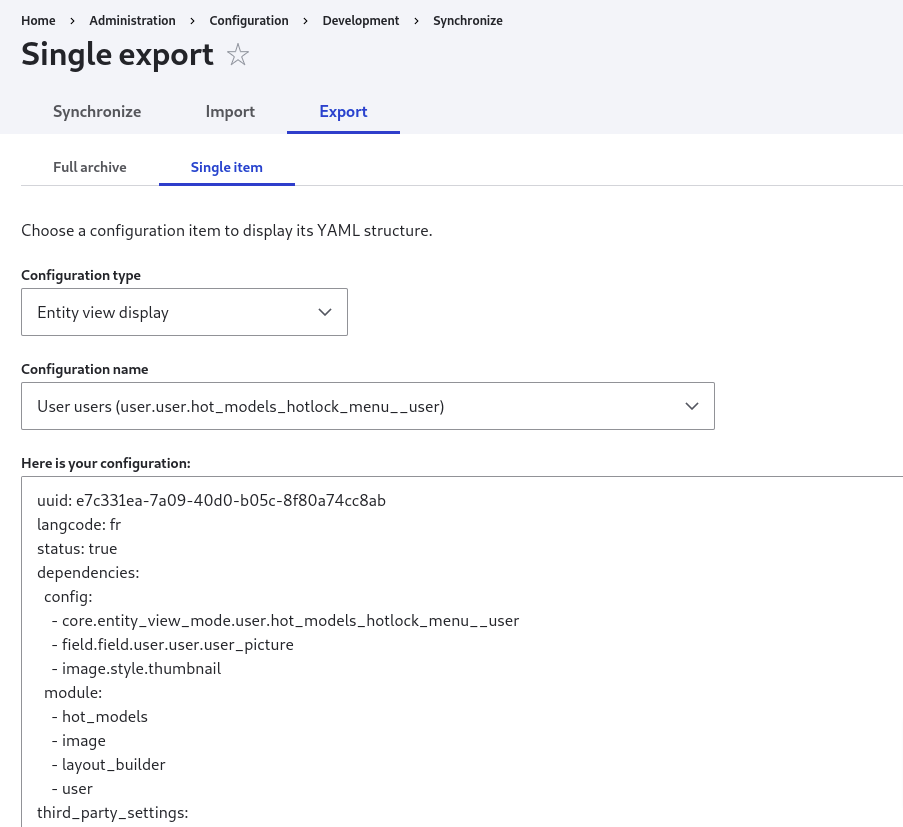Developing a website is a difficult and repetitive task. Most websites have common information such as teasers, page templates, sections, profiles, compact profiles, and dashboards.
We will save a significant amount of time if we can import most configurations, either during development or during the installation process of Drupal or a module.
The Drupal team has looked into these issues and provides us with basic tools to solve them. The module is called config and is part of the core; it is installed by default in the standard profile. With this module, we can export configurations and import them later.
In order to better understand how it works, let's define a work situation:
Scenario :
We have the following layout:

which contains 3 regions
- un region pour le menu
- a region for the call-to-action button
- a region for profile information.
Profile information appears on hover:

We want to have this profile configuration when installing the module.
We create the layout : hot_models/src/Plugin/Layout/Sections/Menus/HotModelsHotlockMenu.php
Au niveau interface, nous creons un rendu specifique 'hot_models_hotlock_menu__user' and we load this rendering if the user is logged in:
/**
* The user's compact rendering is added if they are logged in.
*/
$uid = \Drupal::currentUser()->id();
if ($uid) {
$user = \Drupal\user\Entity\User::load($uid);
$viewEntity = \Drupal::entityTypeManager()->getViewBuilder('user');
$build['user_compact'] = $viewEntity->view($user, 'hot_models_hotlock_menu__user');
}
On a basic Drupal installation, the ‘hot_models_hotlock_menu__user’ mode does not exist, so it would need to be created during installation and the necessary components added.
To achieve this, we must export the display model.'hot_models_hotlock_menu__user':

The name of this configuration is available at the bottom of the export page. We need to create a file with this name and add the configuration content to it:
In this case, the file is named : core.entity_view_display.user.user.hot_models_hotlock_menu__user.yml
The file must be in hot_models/config/install
There is an important section in the configuration content. : "dependencies:" which generally contains two entries, config: which contains the configurations that are mandatory and "module:" which contains the required modules.
In our case, we have:
...
dependencies:
config:
- core.entity_view_mode.user.hot_models_hotlock_menu__user
- field.field.user.user.user_picture
- image.style.thumbnail
module:
- hot_models
- image
- layout_builder
- user
...
On that point, we must import. 'core.entity_view_mode.user.hot_models_hotlock_menu__user' because the latter does not exist on Drupal, but the rest exists on a standard Drupal installation.
The next configuration : (core.entity_view_mode.user.hot_models_hotlock_menu__user.yml )
uuid: 6fa85a79-970e-4d1c-9b29-9a3ab6eab2e4
langcode: fr
status: true
dependencies:
module:
- user
id: user.hot_models_hotlock_menu__user
label: 'User model flat (hot_models module)'
targetEntityType: user
cache: true
NB: Since this configuration is linked to the module, it must be deleted when the module is uninstalled. enforced at the level of the key dependencies :
...
status: true
dependencies:
config:
- core.entity_view_mode.user.hot_models_hotlock_menu__user
- field.field.user.user.user_picture
- image.style.thumbnail
module:
- hot_models
- image
- layout_builder
- user
enforced:
module:
- hot_models
third_party_settings:
layout_builder:
...
And there you have it, when you install your module, you will have this block that will be automatically configured.
Ressources :





